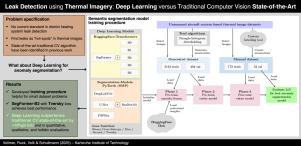Leak detection using thermal imagery: Deep learning versus traditional computer vision state-of-the-art
IF 12.2
1区 地球科学
Q1 GEOGRAPHY, PHYSICAL
ISPRS Journal of Photogrammetry and Remote Sensing
Pub Date : 2025-07-28
DOI:10.1016/j.isprsjprs.2025.06.006
引用次数: 0
Abstract
As a cornerstone of climate-neutral heat supply in urban areas, district heating systems require monitoring to detect and mitigate leaks in their subterranean pipelines. Recent research has focused on an approach involving thermography, where leaks are detected as hot-spots in remote sensing imagery. To this end, various traditional computer vision algorithms have been implemented to automate anomaly detection.
This paper pursues a new approach that has so far received little attention in the context of leak detection in district heating pipelines: deep learning, specifically supervised semantic segmentation. By creating a generalisable, multi-stage training procedure to tackle the prevalent limited dataset problem, various architectures are tailored to this anomaly detection task, of which the SegFormer-B2 with Tversky loss is found to perform best. Via comprehensive quantitative, qualitative, explainable AI, and holistic evaluation, the model is assessed and compared to state-of-the-art traditional algorithmic alternatives. It is found to excel, outperforming previous intersection over union scores by almost 10 %pt and maintaining a high precision with little detriment to recall and detection rate.

使用热图像进行泄漏检测:深度学习与传统计算机视觉技术的对比
作为城市地区气候中性供热的基石,区域供热系统需要监测,以检测和减轻地下管道的泄漏。最近的研究集中在一种涉及热成像的方法上,这种方法可以在遥感图像中作为热点检测泄漏。为此,已经实现了各种传统的计算机视觉算法来自动检测异常。本文采用了一种迄今为止在区域供热管道泄漏检测中很少受到关注的新方法:深度学习,特别是监督语义分割。通过创建一个通用的、多阶段的训练过程来解决普遍的有限数据集问题,针对这种异常检测任务定制了各种架构,其中发现具有Tversky损失的SegFormer-B2表现最好。通过全面的定量、定性、可解释的人工智能和整体评估,对模型进行评估,并与最先进的传统算法替代方案进行比较。我们发现它非常出色,比之前的union分数高出近10%,并且在对召回率和检测率几乎没有损害的情况下保持了很高的精度。
本文章由计算机程序翻译,如有差异,请以英文原文为准。
求助全文
约1分钟内获得全文
求助全文
来源期刊

ISPRS Journal of Photogrammetry and Remote Sensing
工程技术-成像科学与照相技术
CiteScore
21.00
自引率
6.30%
发文量
273
审稿时长
40 days
期刊介绍:
The ISPRS Journal of Photogrammetry and Remote Sensing (P&RS) serves as the official journal of the International Society for Photogrammetry and Remote Sensing (ISPRS). It acts as a platform for scientists and professionals worldwide who are involved in various disciplines that utilize photogrammetry, remote sensing, spatial information systems, computer vision, and related fields. The journal aims to facilitate communication and dissemination of advancements in these disciplines, while also acting as a comprehensive source of reference and archive.
P&RS endeavors to publish high-quality, peer-reviewed research papers that are preferably original and have not been published before. These papers can cover scientific/research, technological development, or application/practical aspects. Additionally, the journal welcomes papers that are based on presentations from ISPRS meetings, as long as they are considered significant contributions to the aforementioned fields.
In particular, P&RS encourages the submission of papers that are of broad scientific interest, showcase innovative applications (especially in emerging fields), have an interdisciplinary focus, discuss topics that have received limited attention in P&RS or related journals, or explore new directions in scientific or professional realms. It is preferred that theoretical papers include practical applications, while papers focusing on systems and applications should include a theoretical background.
 求助内容:
求助内容: 应助结果提醒方式:
应助结果提醒方式:


